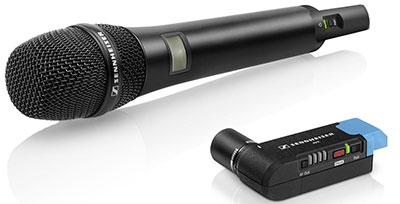
Convenience starts with not having to register the system or pay for its use: AVX operates in the license-free 1.9 GHz frequency range, which can be used in many countries worldwide. The convenience continues in operation: the plug-on receiver automatically switches on with the phantom powering of the camera, and automatically pairs with the transmitter. The system immediately sets the correct audio level, perfectly matching it to the camera’s input sensitivity, selects a free frequency – and is ready for the job at hand. If a source of interference appears, AVX will inaudibly shift to a new frequency.
The AVX receiver and transmitter are powered by special lithium-ion batteries, which can be recharged via a USB port. To avoid nasty surprises when filming for a long time, the transmitters display the amount of battery life remaining.
For DSLRs with a jack audio input, the AVX systems include an XLR-3/mini-jack adapter cable and the mounting accessories needed to attach the receiver to the camera hotshoe.
AVX is available in three different sets: with a handheld transmitter (evolution microphone head); with a bodypack transmitter and ME 2 clip-on microphone; and in a special professional version with a bodypack transmitter and an MKE 2 clip-on microphone, the benchmark product for film and TV productions.
For the USA, a special combo pack is issued, which includes both a bodypack and a handheld. The microphone head is an MMD 42, the capsule of Sennheiser’s long-standing MD 42 reporter’s microphone. All system components ‑ plus additional items such as a handheld transmitter with on/off switch -‑ are available separately so that users can put together their own tailor-made AVX systems.
The AVX systems and components will be available in June 2015. Specifics are here.